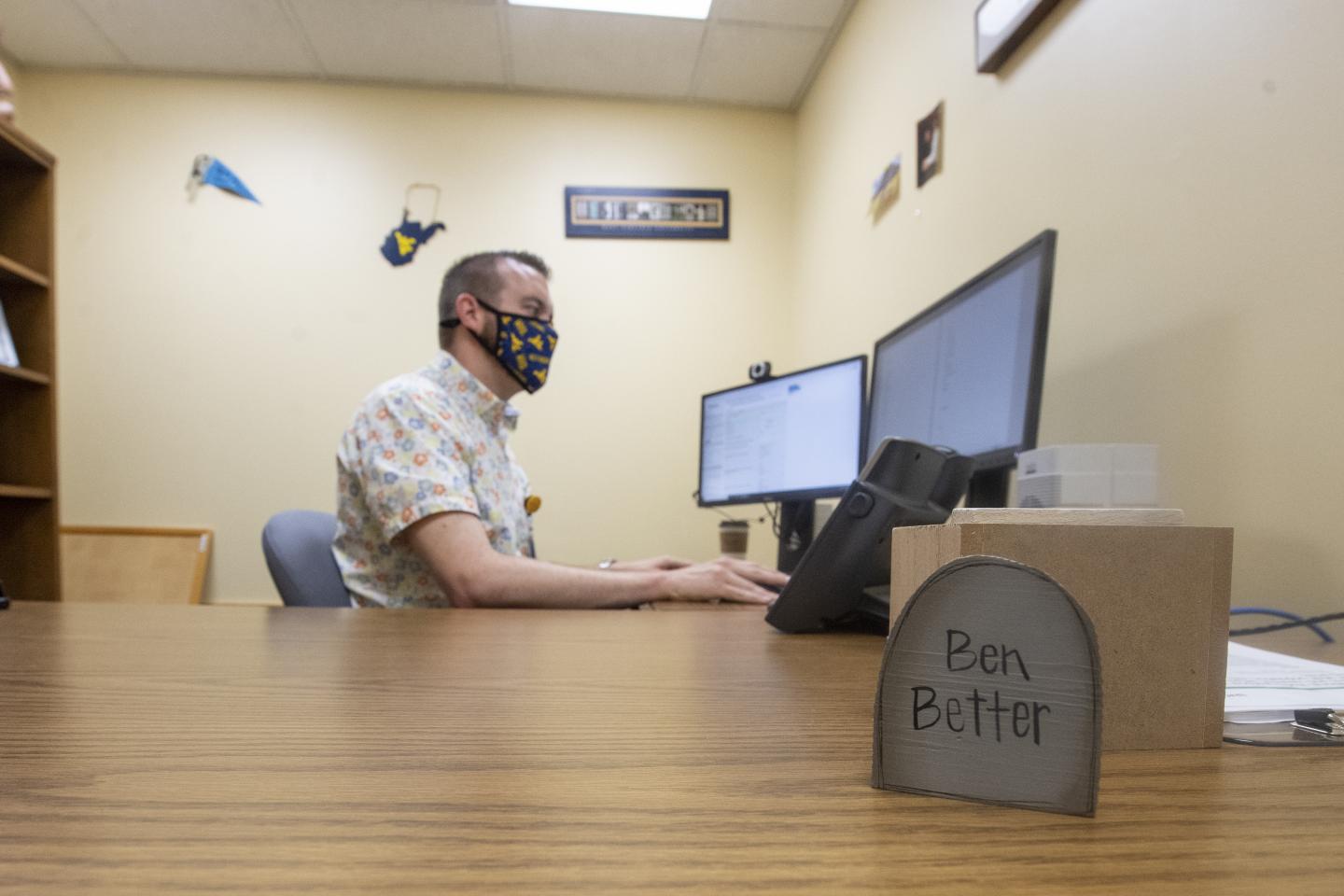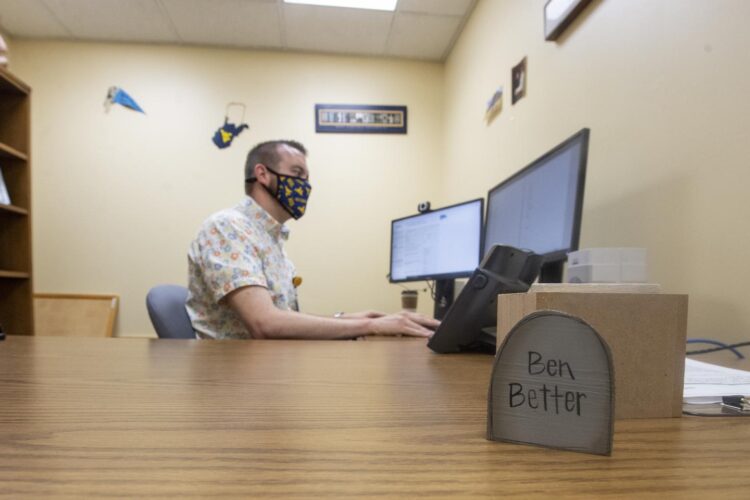
Credit: Brian Persinger/WVU
More than ever, patients are using telehealth to ask doctors and nurses about worrying blood-pressure readings, nauseating migraines and stubborn foot ulcers. But for patients with chronic conditions, how frequent should telehealth appointments be? Can that frequency change? Under what conditions?
West Virginia University researcher Jennifer Mallow is trying to answer these questions. In a new project, she and her colleagues completed a systematic review of studies that dealt with telehealth and chronic conditions. They found that–in general–telehealth services benefitted patients more if they continued for about a year, rather than ending after six months or so. But perhaps their most significant finding was just how much we have left to discover.
“As researchers, we recognized there is a gap in the current science,” said Mallow, an associate professor in the School of Nursing’s Adult Health Department. “We don’t know how much or how often telehealth should be used to impact outcomes yet. So, we needed to do the work in order to push what we know about telehealth forward.”
Their findings appear in E-Health Telecommunication Systems and Networks.
The systematic review included “quasi-experimental” tests as well as randomized controlled trials. It encompassed three types of telehealth services: synchronous (including real-time videoconferencing), asynchronous (such as exchanging messages) and remote patient monitoring (reviewing readings from devices like glucometers).
Regardless of the form telehealth took, Mallow and her team found that it produced positive results in patients who received the services for 51 weeks. In contrast, telehealth durations of 37 or 38 weeks produced mixed or neutral results.
But the data weren’t plentiful enough for the researchers to draw any conclusions about the best dose of telehealth to improve care effectiveness, quality, safety and cost. For instance, how often–and for how long–should a patient with diabetes use remote patient monitoring to submit her blood sugar readings to her healthcare provider? What if her readings have been healthy and stable for a month? What if they’ve worsened for a week? What if she has high blood pressure in addition to diabetes?
“Even though we’ve been doing the ramp-up of telehealth for over a year, we still don’t have the answers to these questions,” Mallow said. “It’s because this is implementation science. This is not work that’s done in the lab. So, my plea–during the booming amount of work that’s being done in telehealth research–is that we need to measure dose in standard and specific ways.”
Mallow and her team are doing just that. As part of the “Take Me Home, West Virginia” program, they are delivering telehealth services to West Virginians, tracking those services and identifying how they influence particular health metrics.
The program is federally funded by the Centers for Medicare and Medicaid Services. It supports state Medicaid programs–including the West Virginia Department of Health and Human Resources’ Bureau for Medical Services–to give older adults and people with disabilities a greater choice in where they get long-term care.
“We’re collecting information related to dose,” Mallow said. “How long do we spend with participants? What are the nurses doing, and how long does it take them? How long does it take us to review remote patient monitoring? Are we talking to patients on the phone? As we collect this information in a standard way, we can begin to make those links between dose and outcome.”
Ben Klos–a registered nurse, faculty member in the School of Nursing and member of Mallow’s research team–provides clinical services to the telehealth patients through the “Take Me Home, West Virginia” program. He spends much of his time reviewing telehealth patients’ records and following up with them when symptoms arise.
“Our participants get sent a tablet, which helps them collect their vitals–mostly blood pressure, pulse and oxygen levels–and asks them disease-specific questions,” Klos said. “If I see an abnormality in their vitals or answers, I call and check on them. For us, dosing helps us understand how long an intervention should be to benefit the patient while preventing device fatigue.”
Another part of Klos’ job is calling patients every two weeks to collect survey data about their alcohol use and signs of anxiety, depression and loneliness. Those phone calls can be especially important for patients with more than one chronic condition because, as a group, those patients score higher than average on measures of loneliness.
“We know that people with multiple chronic conditions have higher loneliness scores and that these scores are linked to functional decline, depressive symptoms and poorer physical health outcomes, including higher blood pressure,” said Laurie Theeke, a professor and director of the Ph.D. Program at the School of Nursing, and part of the research team. “Using telehealth to connect with chronically lonely people in a way that works to diminish loneliness and enhance their perception of belonging could be key to improving measures of chronic illness control.”
Telehealth could also be key to addressing some of the health problems that bedevil West Virginia. The state consistently has some of the highest rates of diabetes, obesity, coronary heart disease, COPD and other chronic conditions. In addition, it ranks sixth in the nation for poverty.
“Lack of access to healthcare services, transportation options and social supports are social determinants of health that have contributed to health disparities such as heart disease, diabetes and depression in West Virginia,” said Steve Davis, an associate professor in the School of Public Health who was involved with the study. “Telehealth has the potential to address these service and support gaps.”
For instance, telehealth could improve rural patients’ access to medical specialists–like cardiologists, neurologists, endocrinologists and psychiatrists–whose offices are a long drive away.
That’s particularly important because, as the Association of American Medical Colleges reports, three out of five federally designated health-professional-shortage areas are in rural locations.
“If you’re going to use telehealth for chronic conditions, the various professional bodies need to come out with recommendations for when and how often,” Mallow said. “The American Diabetes Association might say you should see your patients in person at least once per year to do a foot exam but could use telehealth for other follow-up care, for example. But before they do that, we need rigorous research studies so that they can make those determinations.”
###
Citation
Title: Dose of Telehealth to Improve Community-Based Care for Adults Living with Multiple Chronic Conditions: A Systematic Review
DOI: https:/
Link: https:/
Media Contact
Wendi MacKay, WVU School of Nursing
[email protected]
Original Source
https:/





